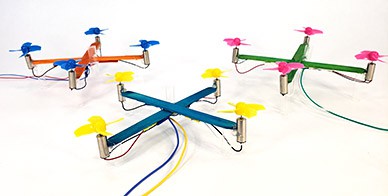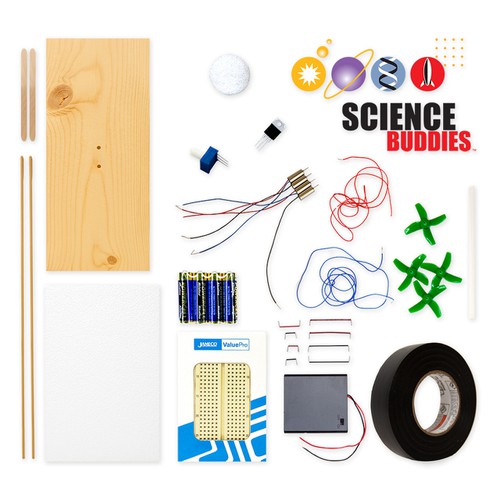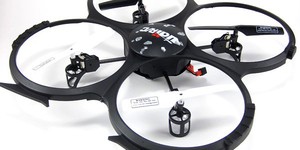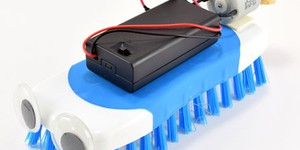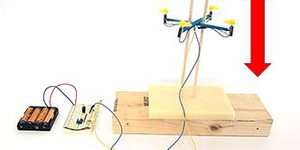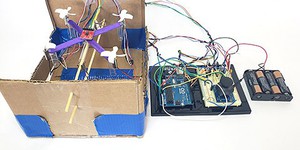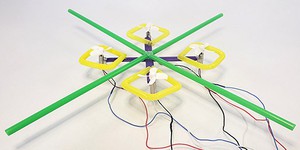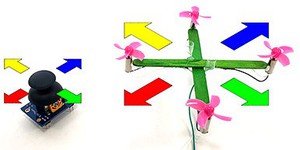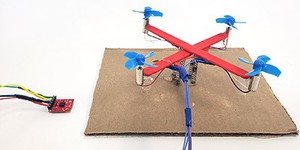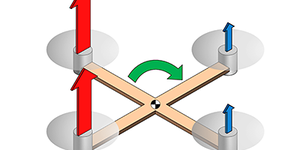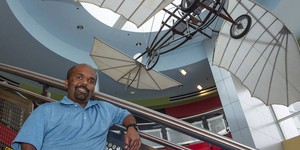Summary
Introduction
Quadcopters, also called drones, are a fun and popular toy. Explore the world of drones as you build your own mini drone using popsicle sticks in this fun activity.
See this page for a complete list of our mini drone projects. You may wish to do the projects in order.
Materials
- DIY Mini Drone Kit, available from our partner Home Science Tools.
Disclaimer: Science Buddies participates in affiliate programs with Home Science Tools, Amazon.com, Carolina Biological, and Jameco Electronics. Proceeds from the affiliate programs help support Science Buddies, a 501(c)(3) public charity, and keep our resources free for everyone. Our top priority is student learning. If you have any comments (positive or negative) related to purchases you've made for science projects from recommendations on our site, please let us know. Write to us at scibuddy@sciencebuddies.org.
Instructions
- Mark the center of two popsicle sticks. Glue them together with hot glue to form a "+" shaped frame.
 Image Credit: Ben Finio, Science Buddies / Science Buddies
Image Credit: Ben Finio, Science Buddies / Science Buddies
- Cut four pieces of straw, 2–3 cm long. Glue the pieces to the ends of each popsicle stick to make legs. The straws are clear, so they are hard to see in this photo.
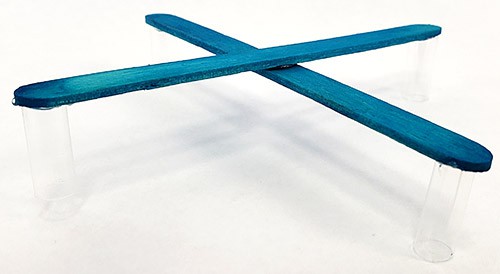 Image Credit: Ben Finio, Science Buddies / Science Buddies
Image Credit: Ben Finio, Science Buddies / Science Buddies
- If needed, cut the connectors off the motor wires. Strip about 1 cm of insulation off of each wire.
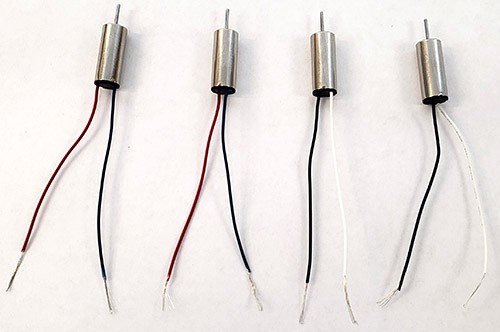 Image Credit: Ben Finio, Science Buddies / Science Buddies
Image Credit: Ben Finio, Science Buddies / Science Buddies
- Glue the motors to the tips of the popsicle sticks, with the wires hanging down by the straws. The motors with red and blue wires should go opposite from each other, and the motors with black and white wires should go opposite from each other.
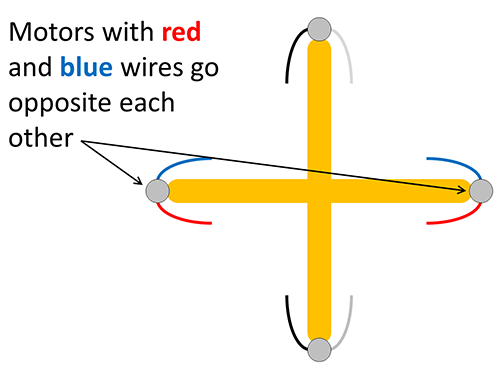 Image Credit: Ben Finio, Science Buddies / Science Buddies
Image Credit: Ben Finio, Science Buddies / Science Buddies
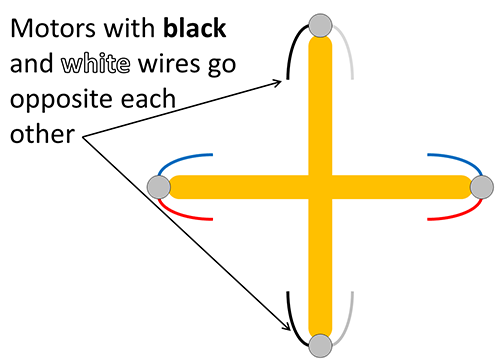 Image Credit: Ben Finio, Science Buddies / Science Buddies
Image Credit: Ben Finio, Science Buddies / Science Buddies
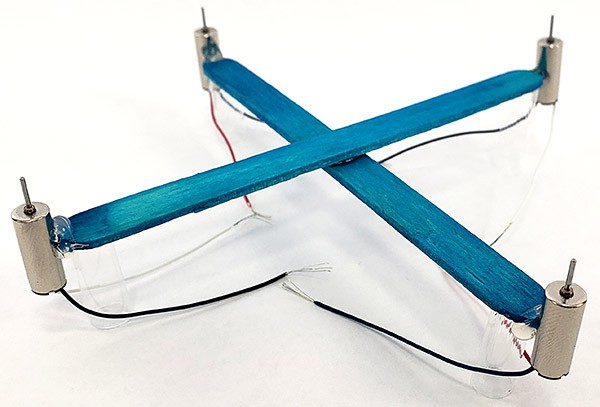 Image Credit: Ben Finio, Science Buddies / Science Buddies
Image Credit: Ben Finio, Science Buddies / Science Buddies
- Cut two pieces of 30 AWG stranded wire, each about 1 m long. Strip about 1 cm of insulation off the ends.
- Connect all of the red and white motor wires to one of your long pieces of wire. This will be the positive connection to the battery pack. Do this by twisting the ends of the five wires together, and covering the connections with electrical tape. You may need to use additional shorter pieces of wire to make all the connections if the motor wires are not long enough. In this picture, the red and white motor wires are all connected to the long yellow wire.
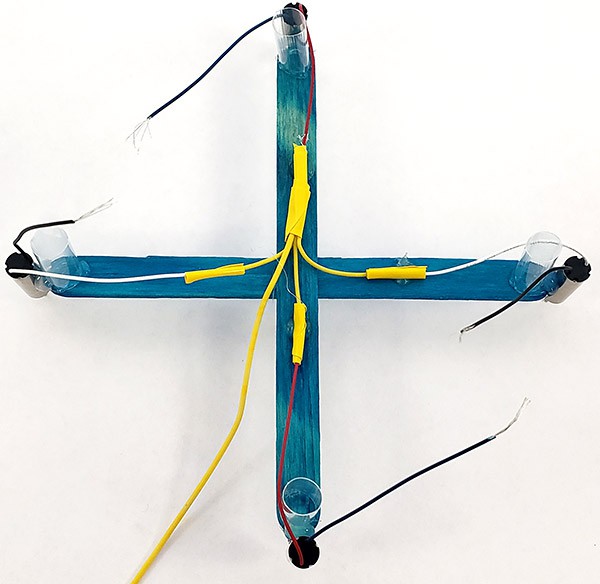 Image Credit: Ben Finio, Science Buddies / Science Buddies
Image Credit: Ben Finio, Science Buddies / Science Buddies
- Use the same process to connect all of the blue and black motor wires to your other long piece of wire. This will be the negative connection to the battery pack. In this photo, the black and blue motor wires are all connected to the long blue wire.
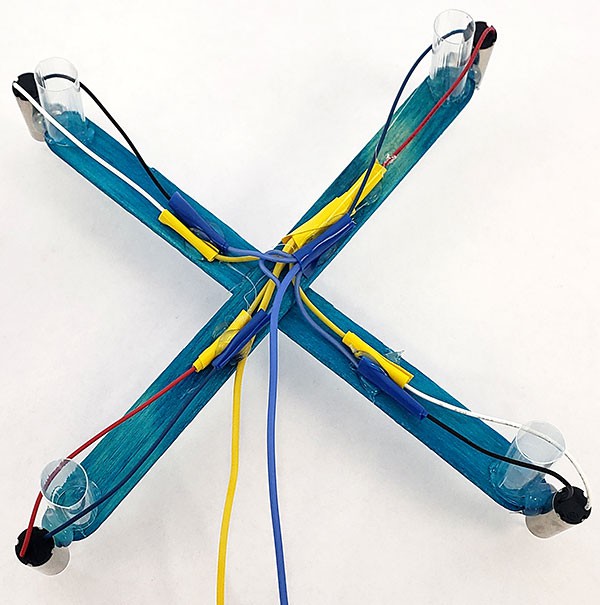 Image Credit: Ben Finio, Science Buddies / Science Buddies
Image Credit: Ben Finio, Science Buddies / Science Buddies
- Glue the wires to the bottom of the frame. This will prevent them from getting caught in the propellers.
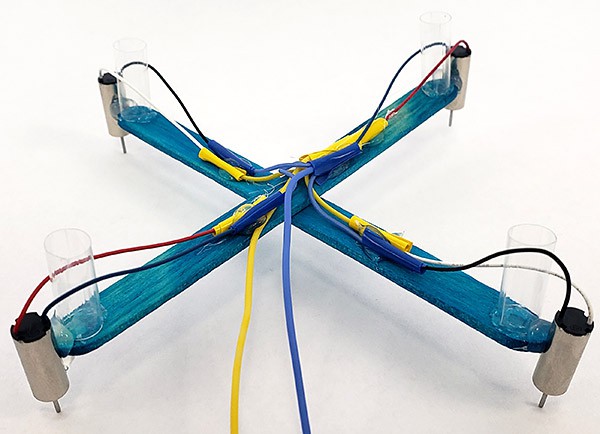 Image Credit: Ben Finio, Science Buddies / Science Buddies
Image Credit: Ben Finio, Science Buddies / Science Buddies
- Press the propellers onto the motor shafts. There are two types of propellers, with their blades tilted in opposite directions: clockwise (CW) and counterclockwise (CCW). The CW propellers go on the motors with red and blue wires, and the CCW propellers go on the motors with black and white wires.
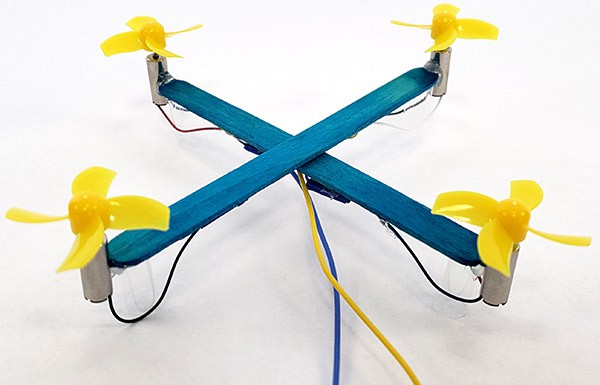 Image Credit: Ben Finio, Science Buddies / Science Buddies
Image Credit: Ben Finio, Science Buddies / Science Buddies
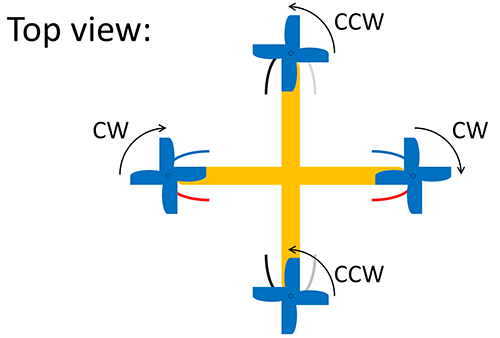 Image Credit: Ben Finio, Science Buddies / Science Buddies
Image Credit: Ben Finio, Science Buddies / Science Buddies
- Glue a piece of straw (roughly 3 cm long) vertically to the side of the middle of the frame.
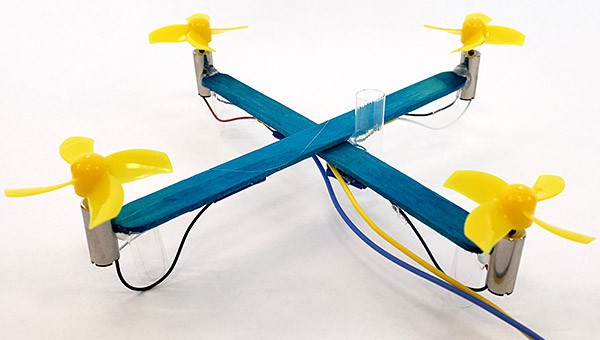 Image Credit: Ben Finio, Science Buddies / Science Buddies
Image Credit: Ben Finio, Science Buddies / Science Buddies
- Connect the drone's positive wire (the one connected to the red/white motor wires) to the battery pack's red wire. Connect the drone's negative wire (the one connected to the blue/black motor wires) to the battery pack's black wire. Cover the connections with electrical tape.
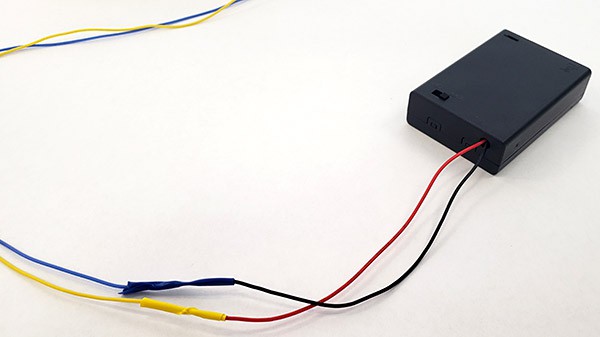 Image Credit: Ben Finio, Science Buddies / Science Buddies
Image Credit: Ben Finio, Science Buddies / Science Buddies
- Make sure the battery pack is off, and insert the batteries.
- Get ready to test your drone! Turn the battery pack on, and your drone should rise up into the air. Quickly turn the battery pack off before it crashes.
- Build a support for the wooden dowel, which will act as a guide pole for your drone. For example, you can drill a hole in a block of wood, or duct tape the dowel to something sturdy. You could also get a volunteer to hold the dowel. Make sure the dowel fits through the vertical straw on your drone. Alternatively, instead of a dowel, you can use a piece of string. Tape the string to the top of a door frame and pull it tight from the bottom.
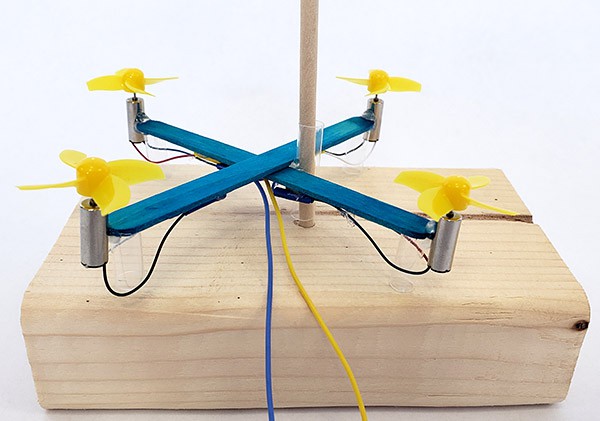 Image Credit: Ben Finio, Science Buddies / Science Buddies
Image Credit: Ben Finio, Science Buddies / Science Buddies
- Thread the drone onto the dowel (or string) through the straw mounted on the frame, then test it again. Your drone should now fly vertically. Turn it off before it flies off the top of the dowel.
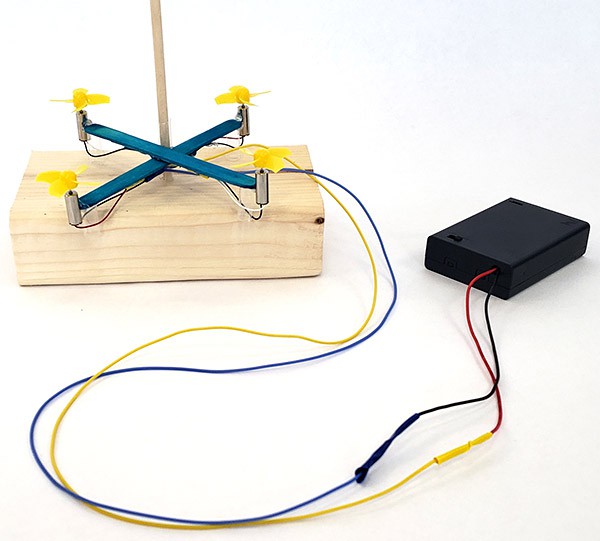 Image Credit: Ben Finio, Science Buddies / Science Buddies
Image Credit: Ben Finio, Science Buddies / Science Buddies
- If your drone does not fly, here are some troubleshooting steps:
- Make sure all four propellers are spinning. If one or more propellers are not spinning, double-check that you do not have any loose wires.
- Make sure that the propellers are spinning in the correct direction. If you hold the drone upright in your hand, you should be able to feel the drone blowing air down like a fan. If you feel air blowing up, then one or more propellers might be spinning backwards. You might need to reverse the direction of a motor's wires, or swap propellers between motors.
- Make sure that there is slack in the long wires that connect to the battery pack. If these wires are too tight, they will pull the drone down.
- See the Further Exploration section for more ideas that you can try with your drone!
What Happened?
When you turn the battery pack on, your drone's propellers spin, generating lift. When the lift is greater than the drone's weight, it flies up into the air! If you got any of your motor wires backwards, you might have had trouble getting your drone to fly at first. Wiring a motor backwards will cause the propeller to blow air up, not down. For your drone to fly, the propellers need to push air down.
You wired your motors such that two spin clockwise and two spin counterclockwise. This way, the angular momentum of all four propellers cancels out, and the drone does not spin. If you wire the motors such that all four spin in the same direction, this will cause the whole drone to spin in the opposite direction and get its wires twisted around the guide pole.
If your drone flew off the top of the wooden dowel, it probably crashed. Read the Digging Deeper section to learn more about drones and how engineers prevent them from crashing.
Digging Deeper
The drone you built in this project has a very simple circuit. When you turn the battery pack on, all four motors spin at full speed and generate lift. The drone keeps going up until it flies off the guide pole and crashes. Even if you try to rapidly turn the battery pack on and off, it is very difficult to make the drone hover at a constant height. Your drone was also connected to an external battery pack with long wires, which meant it could not fly very far.
The circuits on a real drone are more complicated. First, the drone must carry an on-board battery so it can fly without being attached to wires. A human operator can then steer the drone with radio control, which means it needs a circuit for wireless communication. To steer, the drone changes the speed of its motors. For example, it can speed the motors up to fly higher, and slow the motors down to fly lower. It can move sideways by spinning the motors on one side faster than the other side, which causes the drone to tilt left, right, forward, or backward. The human operator usually controls these motions with joysticks on a controller, just like a video game.
Many drones also have an on-board computer, or electronic "brain," that does some of the steering for you. This computer is connected to electronic sensors that measure things like the drone's angle of tilt, its distance from the ground, or the distance to nearby obstacles like trees or buildings. The drone's programming helps it stay level, avoid obstacles, and fly at a fixed height. This way, the human operator can concentrate on steering the drone, without constantly worrying that the drone will flip upside-down or crash into an obstacle.
Some drones have even more advanced features. For example, some have high-definition cameras used for aerial photography. Others can even use GPS to fly on a pre-planned path or return to a certain location to land. So, even though you started out by building a very simple drone, the sky is (literally) the limit!
Ask an Expert
For Further Exploration
- What happens if you try to fly your drone without the guide pole?
- Can you rapidly turn the battery pack on and off to make your drone "hover" on the guide pole, without hitting the bottom or flying off the top?
- Try adding small weights (like pennies) to your drone. How much weight can it lift?

